Page 572 of 688

5725-2. Steps to take in an emergency
VENZA_OM_OM73030U_(U) ■ If the malfunction indicator lamp comes on while driving
First check the following:
● Is the fuel empty?
If it is, fill the fuel tank immediately.
● Is the fuel tank cap loose?
If it is, tighten it securely.
The malfunction indicator lamp will go off after taking several driving trips.
If the malfunction indicator lamp does not go off even after several trips, con-
tact your Toyota dealer as soon as possible.
■ Key reminder buzzer (vehic les without smart key system)
The buzzer indicates that the key has not been removed with the engine off
and the driver’s door opened.
■ Open moon roof warning buzzer
The buzzer indicates that the moon roof is not fully closed with the engine off
and the driver’s door opened.
■ Front passenger detect ion sensor and passenger seat belt reminder
● If luggage is placed on the front passenger seat, the front passenger
detection sensor may cause the warning light to flash, even if a passen-
ger is not sitting in the seat.
● If a cushion is placed on the seat, the sensor may not detect a passen-
ger, and the warning light may not operate properly.
■ Electric power steering system warning light
When the battery charge becomes insufficient or the voltage temporarily
drops, the electric power steering system warning light may come on.
Page 575 of 688

5
When trouble arises
5755-2. Steps to take in an emergency
VENZA_OM_OM73030U_(U) ■
If the tire pressure warning light frequently comes on after blinking
for 1 minute
Vehicles with smart key system
If the tire pressure warning light frequently comes on after blinking for
1 minute when the “ENGINE START ST OP” switch is turned to IGNI-
TION ON mode, have it checked by your Toyota dealer.
Vehicles without smart key system
If the tire pressure warning light comes on after blinking 1 minute fre-
quently when the engine switch is tu rned to the “ON” position, have it
checked by your Toyota dealer.
CAUTION■
When the electric power steering system warning light comes on
The steering wheel may become extrem ely heavy. If the steering wheel
becomes heavier than usual when operating, hold firmly and operate
using more force than usual.■
If the tire pressure warning light comes on
Be sure to observe the following precautions. Failure to do so could
cause loss of vehicle control and result in death or serious injury. ●
Stop your vehicle in a safe place as soon as possible. Adjust the tire
inflation pressure immediately. ●
If the tire pressure warning light comes on even after tire inflation pres-
sure adjustment, it is pr obable that you have a flat tire. Check the tires.
If the tire is flat, change to the spare tire and have the flat tire repaired
by the nearest Toyota dealer.
●
Avoid abrupt maneuvering and braking. If the vehicle tires deteriorate,
you could lose control of the steering wheel or the brakes.
Page 588 of 688

5885-2. Steps to take in an emergency
VENZA_OM_OM73030U_(U) CAUTION■
When using the compact spare tire ●
Remember that your compact spare tire is specifically designed for
use with your vehicle. Do not use your compact spare tire on another
vehicle.●
Do not use more than one compact spare tire simultaneously.●
Replace the compact spare tire with a standard tire as soon as possi-
ble.●
Avoid sudden acceleration, abrupt steering, sudden braking and shift-
ing operations that caus e sudden engine braking.■
Speed limit when using the compact spare tire
Do not drive at speeds in excess of 50 mph (80 km/h) when a compact
spare tire is installed on the vehicle.
The compact spare tire is not designed for driving at hi gh speeds. Failing
to observe this precaution may lead to an accident causing death or seri-
ous injury.■
When the compact spare tire is attached
The vehicle speed may not be correctly detected, and the following sys-
tems may not operate correctly: ●
ABS & Brake assist●
VSC●
TRAC
●
Cruise control system
●
Intuitive parking assist
●
Rear view monitor system (if equipped)
●
Entune Premium Audio with Navigation (if equipped)
Also, not only can the AWD system no t be utilized fully, it may actually
negatively effect the drive-train components (AWD models only).
Page 590 of 688
5905-2. Steps to take in an emergency
VENZA_OM_OM73030U_(U)If the engine will not star t If the engine still does not start after following the correct starting
procedure ( P. 173, 177) or releasing the steering lock ( P. 175,
178), confirm the following points.
■ The engine will not start even if you are carrying the correct
key.
One of the following may be the cause of the problem.
● There may not be sufficient fuel in the vehicle’s tank.
Refuel the vehicle.
● The engine may be flooded.
Try to restart the engine once more following correct starting
procedures. ( P. 173, 177)
● There may be a malfunction in the engine immobilizer system.
( P. 109)
■ The starter motor turn over slowly, the interior lights and
headlights are dim, or the horn does not sound or sounds at
a low volume.
One of the following may be the cause of the problem.
● The battery may be discharged. ( P. 598)
● The battery terminal connec tions may be loose or corroded.
Page 591 of 688
5
When trouble arises
5915-2. Steps to take in an emergency
VENZA_OM_OM73030U_(U) ■ The starter motor does not turn over (vehicles with smart
key system).
The engine starting system may be malfunctioning due to an
electrical problem such as an open circuit or a blown fuse. How-
ever, an interim measure is available to start the engine.
(
P. 592)
■ The starter motor does not turn over, the interior lights and
headlights do not turn on, or the horn does not sound.
One of the following may be the cause of the problem.
● One or both of the battery terminals may be disconnected.
● The battery may be discharged. ( P. 598)
● There may be a malfunction in the steering lock system (vehi-
cles with smart key system). Contact your Toyota dealer if the problem cannot be repaired, or if
repair procedures are unknown.
Page 609 of 688
5
When trouble arises
6095-2. Steps to take in an emergency
VENZA_OM_OM73030U_(U) CAUTION■ If the engine has to be turned off while driving
● Power assist for the brake and steering wheel will be lost, making the
brake pedal harder to depress and the steering wheel heavier to turn.
Decelerate as much as possible before turning off the engine.
● Vehicles without a smart key system: Never attempt to remove the key, as
doing so will lock the steering wheel. Vehicles with a smart key sys-
tem: To stop the engine, press
and hold the “ENGINE START
STOP” switch for 2 consecu-
tive seconds or more, or press
it briefly 3 times or more in
succession.
Stop the vehicle in a safe place by the road. STEP 4
Press and hold for 2 seconds or more,
or press briefly 3 times or more
STEP 5
Page 621 of 688
6216-1. Specifications
6
Vehicle specifications
VENZA_OM_OM73030U_(U) Brakes
* 1
: Minimum pedal clearance when depressed with a force of 112 lbf (500 N, 51
kgf) while the engine is running.
* 2
: Parking brake pedal travel when depressed with a force of 67.4 lbf (300 N,
30.6 kgf).
Steering Pedal clearance
* 1
1.1 in. (28 mm) Min.
Pedal free play 0.04
0.12 in. (1.0
3.0 mm)
Brake pad wear limit 0.04 in. (1.0 mm)
Parking brake lining wear limit 0.04 in. (1.0 mm)
Parking brake adjustment
* 2
4
6 clicks
Fluid type SAE J1703 or FMVSS No. 116 DOT 3
Free play Less than 1.2 in. (30 mm)
Page 637 of 688

6376-1. Specifications
6
Vehicle specifications
VENZA_OM_OM73030U_(U) Glossary of tire terminology Tire related term Meaning
Cold tire inflation
pressure Tire pressure when the vehicle has been
parked for three hours or more, or has not
been driven more than 1 mile or 1.5 km under
that condition
Maximum inflation
pressure The maximum cold inflated pressure to which a
tire may be inflated, s hown on the sidewall of
the tire
Recommended
inflation pressure Cold tire inflation pressure recommended by a
manufacturer
Accessory weight The combined weight (in excess of those stan-
dard items which may be replaced) of auto-
matic transmission, power steering, power
brakes, power windows, power seats, radio
and heater, to the extent that these items are
available as factory-installed equipment
(whether installed or not)
Curb weight The weight of a motor vehicle with standard
equipment, including the maximum capacity of
fuel, oil and coolant, and if so equipped, air
conditioning and additional weight optional
engine
Maximum loaded
vehicle weight The sum of:
(a) Curb weight
(b) Accessory weight
(c) Vehicle capacity weight
(d) Production options weight